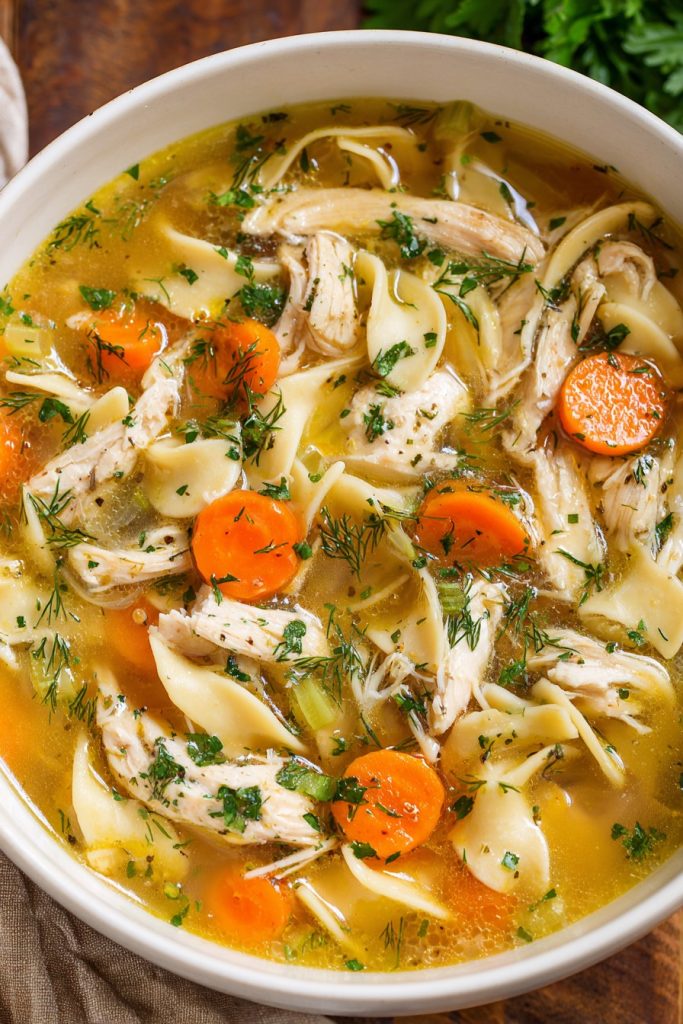Huddle up, soup lovers! There’s nothing quite like a steaming bowl of homemade chicken noodle soup to warm your soul and chase away the chills. This classic comfort food is about to become your new go-to recipe for cozy nights and sick-day remedies alike.
Why This Recipe Works
- Using a whole chicken creates incredibly rich, flavorful broth that store-bought versions simply can’t match
- Simmering the vegetables before adding broth develops deep, caramelized flavors that transform ordinary soup into extraordinary comfort food
- Cooking the noodles separately prevents them from becoming mushy and absorbing all your precious broth
- Adding fresh herbs at the end preserves their bright, vibrant flavor that gets lost during long cooking
- The combination of thyme, bay leaves, and parsley creates a classic flavor profile that feels both nostalgic and perfectly balanced
Ingredients
- 1 whole chicken (3-4 pounds), cut into pieces
- 2 tablespoons olive oil
- 1 large yellow onion, diced
- 3 carrots, peeled and sliced into 1/4-inch rounds
- 3 celery stalks, sliced into 1/4-inch pieces
- 4 cloves garlic, minced
- 12 cups cold water
- 2 bay leaves
- 1 teaspoon dried thyme
- 2 teaspoons salt
- 1 teaspoon black pepper
- 8 ounces egg noodles
- 1/4 cup fresh parsley, chopped
- 2 tablespoons fresh dill, chopped (optional)
- 1 tablespoon lemon juice
Equipment Needed
- Large stockpot or Dutch oven (8-quart minimum)
- Cutting board and sharp knife
- Measuring cups and spoons
- Slotted spoon or spider strainer
- Large bowl for shredding chicken
- Medium pot for cooking noodles
- Colander
- Tongs
Instructions

Prepare and Brown the Chicken
Heat the olive oil in your large stockpot over medium-high heat until it shimmers and easily coats the bottom of the pot. Pat the chicken pieces dry with paper towels—this is crucial for achieving that beautiful golden brown color rather than steaming the chicken. Carefully place the chicken pieces skin-side down in the hot oil, working in batches if necessary to avoid overcrowding. Cook for 5-7 minutes until the skin is deeply golden brown and releases easily from the pot. Flip and cook for another 3-4 minutes until the other side develops some color. Remove the chicken to a plate using tongs, leaving the rendered fat and browned bits in the pot—these little flavor bombs will make your broth incredible.
Sauté the Aromatics and Vegetables
Reduce the heat to medium and add the diced onion to the same pot, scraping up any browned bits from the bottom. Cook for 3-4 minutes until the onion becomes translucent and slightly softened. Add the carrots and celery, stirring to coat them in the flavorful oil. Cook for another 5-6 minutes, stirring occasionally, until the vegetables begin to soften and develop some golden edges. Add the minced garlic and cook for just 30-45 seconds until fragrant—be careful not to burn it as bitter garlic will ruin your soup. The vegetables should be tender but still have some texture at this stage.
Simmer to Create Rich Broth
Return all the chicken pieces to the pot along with any accumulated juices. Pour in the cold water—starting with cold water helps extract maximum flavor from the chicken bones. Add the bay leaves, dried thyme, salt, and pepper. Bring the mixture to a boil over high heat, then immediately reduce to a gentle simmer where small bubbles occasionally break the surface. Partially cover the pot and simmer for 45-60 minutes, until the chicken is completely tender and falling off the bone. Skim off any foam or fat that rises to the surface during the first 15 minutes of cooking for a clearer broth.
Shred Chicken and Cook Noodles
Using tongs, carefully remove all chicken pieces from the broth and transfer to a large bowl to cool slightly. While the chicken cools, bring a separate medium pot of salted water to a rolling boil for the noodles. Cook the egg noodles according to package directions, usually 6-8 minutes, until al dente—they should still have a slight bite to them. Drain immediately in a colander and rinse briefly with cool water to stop the cooking process and prevent them from becoming mushy. Meanwhile, when the chicken is cool enough to handle, shred the meat using two forks, discarding the skin and bones.
Combine and Finish the Soup
Return the shredded chicken to the broth in the stockpot. Add the cooked noodles and bring the soup back to a gentle simmer over medium heat—this should take about 3-4 minutes. Taste and adjust seasoning with additional salt and pepper if needed. Remove the pot from heat and stir in the fresh parsley, dill (if using), and lemon juice. The acid from the lemon juice brightens all the flavors and makes the soup taste fresher. Let the soup stand for 5 minutes before serving to allow the flavors to meld together beautifully.
Tips and Tricks
For an even richer, more gelatinous broth that will jiggle when chilled, consider using chicken backs, necks, or feet in addition to your whole chicken—these parts contain more collagen that transforms into luxurious mouthfeel when simmered. If you’re short on time, you can use a rotisserie chicken; simply skip the browning step and use 8 cups of good quality chicken broth instead of water, simmering for just 20 minutes to meld flavors. To make this soup ahead, prepare everything except the noodles—store the broth and shredded chicken separately, then add freshly cooked noodles when reheating to prevent them from becoming bloated and soft. For a clearer broth, avoid boiling vigorously once the chicken is added—a gentle simmer extracts flavor without emulsifying fat into the broth, and you can further clarify by straining through a fine-mesh sieve lined with cheesecloth. If you prefer thicker soup, make a slurry with 2 tablespoons of cornstarch and 1/4 cup cold water, then whisk into the simmering soup during the final minutes of cooking. Freeze portions without noodles for up to 3 months—the noodles don’t freeze well but can be added fresh when reheating. For extra depth of flavor, roast your chicken pieces in a 400°F oven for 25-30 minutes before adding to the pot, which creates more browned bits and richer flavor compounds.
Recipe Variations
- Creamy Chicken Noodle: Stir in 1 cup of heavy cream during the last 5 minutes of cooking for a decadent, rich version that feels extra comforting
- Asian-Inspired: Replace egg noodles with rice noodles, add 2 tablespoons of grated ginger with the garlic, use soy sauce instead of salt, and garnish with sliced scallions and a drizzle of sesame oil
- Spicy Southwest: Add 1 diced jalapeño with the vegetables, use 1 tablespoon of cumin and 1 teaspoon of chili powder instead of thyme, and garnish with avocado slices and lime wedges
- Italian Wedding Style: Add 1 pound of small meatballs during the last 15 minutes of simmering, use pastina instead of egg noodles, and stir in 2 cups of fresh spinach at the end
- Low-Carb Version: Replace noodles with spiralized zucchini or yellow squash, adding them during the last 3 minutes of cooking just to heat through while maintaining crunch
Frequently Asked Questions
Can I use boneless chicken breasts instead of a whole chicken?
While you can use boneless, skinless chicken breasts, you’ll sacrifice significant flavor and richness. The bones, skin, and dark meat from a whole chicken contribute collagen that transforms into gelatin during cooking, giving the broth body and mouthfeel that boneless breasts simply can’t provide. If you must use breasts, brown them well first and consider adding a tablespoon of unflavored gelatin to the broth to compensate for the missing collagen. Cook boneless breasts for only 20-25 minutes to prevent them from becoming tough and dry.
How long will leftover chicken noodle soup keep in the refrigerator?
Properly stored in an airtight container, your homemade chicken noodle soup will keep for 3-4 days in the refrigerator. The noodles will continue to absorb broth and become softer over time, so if you prefer firmer noodles, consider storing the soup and noodles separately. When reheating, bring to a gentle simmer on the stove rather than boiling vigorously, which can make the chicken tough and the noodles mushy. If the soup becomes too thick after refrigeration, thin it with a little water or additional broth when reheating.
Can I make this soup in a slow cooker or Instant Pot?
Absolutely! For slow cooker: brown chicken and sauté vegetables as directed, then transfer everything except noodles and fresh herbs to the slow cooker. Cook on low for 6-8 hours or high for 3-4 hours. Shred chicken, then add cooked noodles and herbs. For Instant Pot: use sauté function to brown chicken and vegetables, then add water and seasonings. Pressure cook on high for 15 minutes, natural release for 10 minutes, then quick release. Shred chicken, add cooked noodles and herbs. Both methods yield excellent results but the stovetop method gives you more control over the broth’s clarity and flavor development.
Why did my noodles absorb all the broth overnight?
This is the most common complaint with chicken noodle soup! Noodles are essentially starch sponges that continue to absorb liquid even after cooking. The best solution is to store soup and noodles separately, combining them only when ready to serve. If you’ve already combined them, you can add more broth or water when reheating, though the texture will never be quite the same. Another trick is to slightly undercook the noodles initially, so they finish absorbing liquid in the soup without becoming overly soft. Egg noodles are particularly absorbent, so consider using wider noodles or even dumplings if you plan to have leftovers.
Can I freeze chicken noodle soup?
You can freeze the broth and chicken components beautifully for up to 3 months, but I strongly recommend freezing without the noodles. Cooked noodles become mushy and unpleasant when frozen and thawed due to the formation of ice crystals that rupture their starch structure. Freeze the soup in portion-sized containers, leaving about an inch of headspace for expansion. When ready to enjoy, thaw overnight in the refrigerator, reheat on the stove, and add freshly cooked noodles. The broth may separate during freezing—this is normal; just whisk vigorously while reheating to re-emulsify the fat.
Summary
This homemade chicken noodle soup delivers incredible flavor through careful browning, simmering, and fresh finishes. Perfect for cozy nights or comforting sick days, it beats canned soup every time.
Homemade Chicken Noodle Soup
5
servings20
minutes1
minutesIngredients
Instructions
- 1 Brown chicken pieces in olive oil, then remove from pot
- 2 Sauté onions, carrots, celery, and garlic in the same pot
- 3 Return chicken to pot, add water and seasonings, simmer 45-60 minutes
- 4 Remove chicken, shred meat, and cook noodles separately
- 5 Combine everything, add fresh herbs and lemon juice, serve hot



